Ainu Peopleアイヌ民族について
The Ainu are the indigenous people of northern Japan.
アイヌは、日本列島北部の先住民族です。
Their culture is rooted in a spiritual reverence for the natural world and what has historically been a hunter-gatherer lifestyle, as well as extensive contact with surrounding cultures.
The Ainu have unique customs, language, and beliefs.
アイヌ文化は、自然界への敬意や狩猟採集の暮らし、さらに周辺の諸文化との幅広い接触に根ざしており、独自の慣習・言語・信仰を有しています。
From the end of the Jomon period (500 BCE) on, Hokkaido’s culture developed separately from the rest of the Japanese archipelago. Rice cultivation was adopted on the islands of Honshu, Shikoku, and Kyushu to the south, but the hunter-gatherer lifestyle continued in Hokkaido.
縄文時代の終わり(紀元前500年頃)以降、北海道の文化は、日本列島の他の地域とは別な形で発展していきました。南の本州・四国・九州では稲作が行われるようになっていきましたが、北海道では狩猟採集の暮らしが続きました。
Ainu culture likely developed from this post-Jomon culture through trade and contact with northern communities around the Sea of Okhotsk, and communities on Honshu.
アイヌ文化は、この続縄文文化から、オホーツク海周辺の北方社会および本州との交易・接触を通して発展していったと考えられています。
This English-language text was created by the Japan Tourism Agency.
この英語解説文は観光庁の地域観光資源の多言語解説整備支援事業で作成しました。
Shamani Ainu様似アイヌ
In the past, "Samani" was pronounced "Shamani". In the Edo period, this was transcribed in several ways, including "シヤマニ" in katakana characters and "射魔尼" or "砂馬荷" in kanji characters.
「様似」は、かつて「シャマニ」と発音されていました。江戸時代はカタカナで「シヤマニ」、漢字で「射魔尼」「砂馬荷」などと記されていました。
It is thought that "様似", the current kanji placename for "Samani", was standardized either in or after the Meiji period. However, "Samani" does not derive from the original name "Shamani"; rather, it is the same word pronounced in two different ways.
「様似」で統一したのは、明治時代以降と言われています。しかし、「シャマニ」は「サマニ」の語源ではなく、同じ言葉を2通りに発音したもの。
In the Ainu language, there is no distinction between the syllables "s" and "sh", which were perceived as the same sound. It seems that in the past many people pronounced "s" as "sh", which is why "sh" sounds can be seen in many Ainu language-derived placenames.
アイヌ語ではサ行音とシャ行音の区別がなく、同じ音として認識されていました。古い時代は「s」をシャ行音で発音する人が多かったようで、昔から使われているアイヌ語地名ではシャ行音がよく見られます。
While the name "Samani" is derived from the Ainu language, there are several theories about its origin. Some of these are preserved through Ainu folklore, such as the theory that the Samani River, which had been called "Tomiesanpet" (River Where Treasure Flows) became known as the "Samunni" (Fallen Tree)" River when the local Ainu people came into contact with Wajin (Mainland Japanese).
「様似」の地名はアイヌ語が語源ですが、由来は諸説あります。本来、「トミエサンペッ(宝がそこに流れる川)」と呼ばれた様似川が、和人との接触の中で「サムンニ(倒れ木)」と呼ばれるようになるなど、アイヌの伝承もいくつか残されています。
You can immerse your mind in history by tracing the Ainu culture of Samani Town, and their contact and interactions with Wajin, through the various historic sites in this region.
様似町のアイヌ文化、和人との接点・交流を、この地のいろいろな史跡から辿り、歴史に思いをはせてみるのはいかがでしょうか。
Scroll the picture to the left and right.画像は左右にスクロールします。

Panoramic view of Samani Town from Mt. Kannon観音山から見た様似町のパノラマ
History and Culture歴史と文化
Hokkaido was not originally a unified island, but was split into Eastern and Western parts.
もともと北海道は一つではなく、東と西の陸地に分かれていました。
Long ago, the North American and Eurasian tectonic plates, which encompassed Hokkaido, collided against each other. When the North American plate overlapped the Eurasian plate, the Hidaka Mountain range, which is called the backbone of Hokkaido, was formed. As a result, a section of the mantle (peridotite), which had previously been deep underground, was thrust to the surface, creating Mount Apoi and the surrounding mountains. This land formation is a rare case worldwide, which is why the area has been designated as a Global Geopark by UNESCO.
その昔、北海道を取り巻いていた北米プレートとユーラシアプレートがぶつかり合い、北米プレートがユーラシアプレートに乗り上げてできたのが、北海道の背骨といわれる日高山脈です。この結果、地下の深い部分にあったマントル(かんらん岩)の一部が突き上げられて地表に現れ、アポイ岳やその周辺の山々を形づくったのです。これは世界的にも希少な例で、UNESCOの世界ジオパークに認定された理由でもあります。
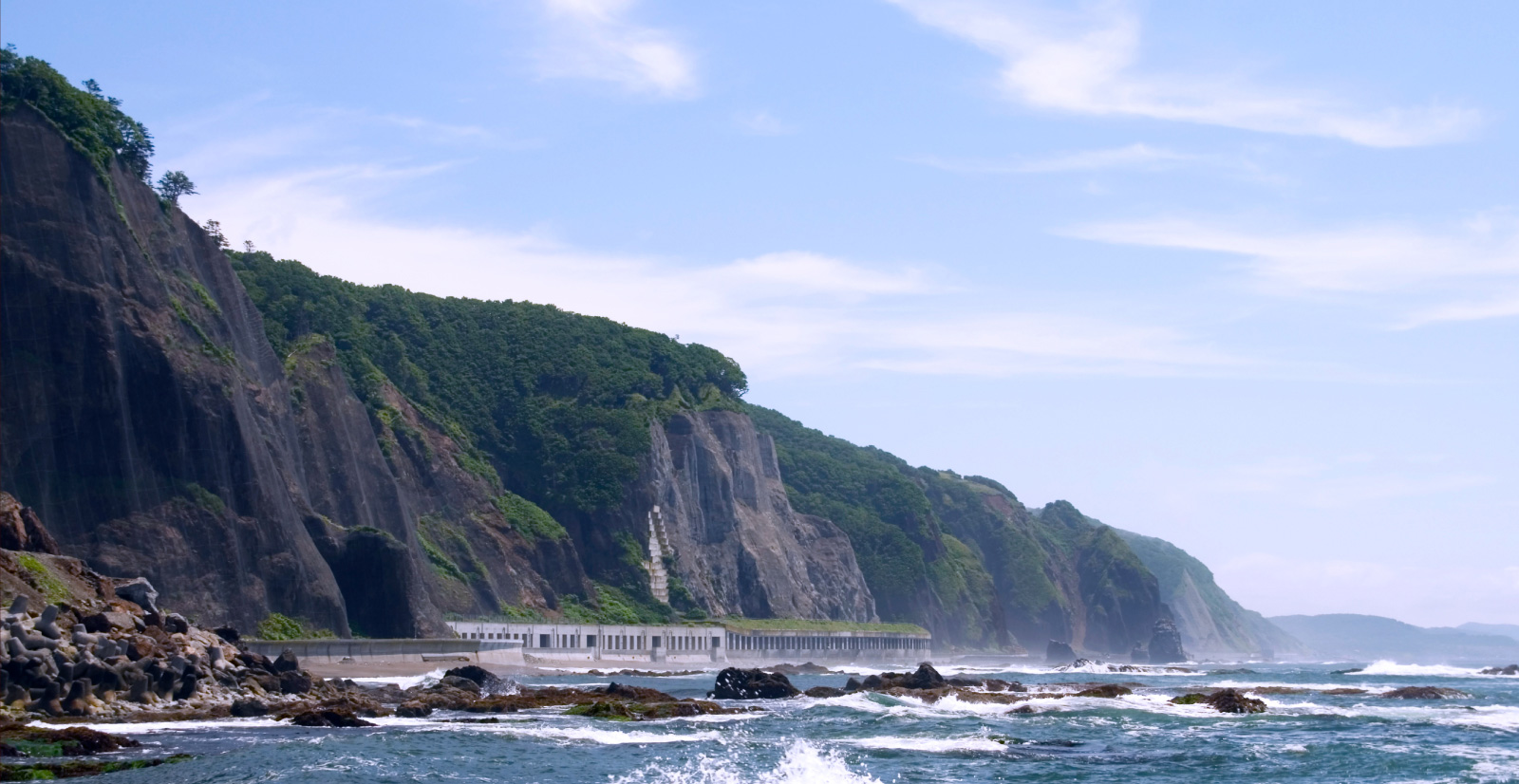
日高耶馬渓
The coastal area contains a series of unique views, known for its shaped rocks, including O-iwa (Great Rock) near Shiogama Tunnel, which was once the gateway to the entrance of Samani Town; Rosoku-iwa (Candle Rock), which is connected to a legend of a giant god, Aynurakkur; as well as Oyako-iwa (Parent and Child Rocks), and Sobira-iwa (Sobira Rock). These rocks were formed by porphyrite, where magma flows into cracks in the geological layers created by movement in the earth's crust.
海岸エリアには、様似町の入り口にあり昔の関門だった塩釜トンネルの大岩、巨大な神さまであるアイヌラックルの伝説が残るローソク岩、ほかにも親子岩、ソビラ岩など、奇岩で知られる独特の景観が続いています。これは、地殻変動によって生まれた地層の割れ目に、マグマが入り込むことでできた「ひん岩」がつくりだしたものです。
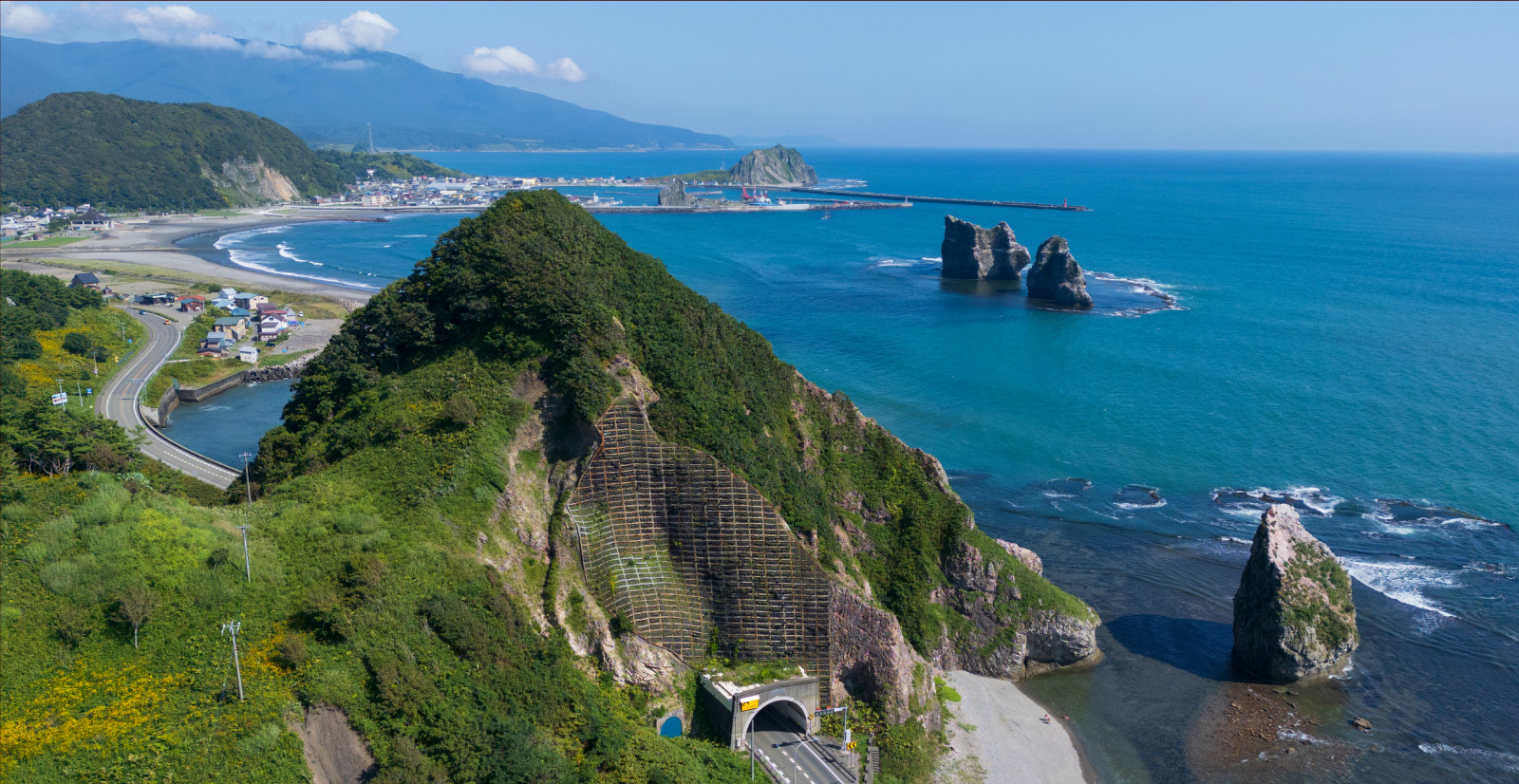
塩釜トンネルとローソク岩(右)、奥に親子岩、ソビラ岩、エンルム岬、アポイ岳が見える。
If we turn our focus to human settlement, it is thought that people first came to live in Samani around the middle and latter stages of the Early Jomon period (approximately 8,000 to 5,000 years ago). Evidence of this can be found in historical sites within the town.
There are differences among the respective Ainu cultures within Hokkaido, with different customs and languages existing even between the East and West parts of the Hidaka region.
人々の暮らしに目を向けると、様似に人が暮らし始めたのは縄文時代早期中葉から後葉(約8,000~5,000年前)といわれており、町内にある遺跡からその様子が見て取れます。
アイヌ文化は北海道内でもそれぞれに違いがあり、日高の東西でも風習や言葉が違います。
The Samani Ainu language is similar to the dialects of East Hokkaido, such as Tokachi and Kushiro, and is observably different to the Ainu language of the West Hidaka region, such as Biratori and Monbetsu.
様似アイヌの言葉は十勝や釧路など道東の方言に似ており、平取や門別などの日高西部のアイヌ語とは異なることがわかっています。
Samani Ainu Culture様似のアイヌ文化
The Samani River, which flows through the center of the town, was called "Tomiesanpet" (River Where Treasure Flows) in the Ainu language.
This name is said to have originated when a treasured "tuki" (ceremonial cup) drifted down the river. At that time, the name for the river was also the name for the surrounding area.
まちの中心部を流れる様似川は、アイヌ語で「トミエサンペッ・宝の流れる川」と呼ばれていました。
由来は、昔、この川に宝物の「ト゚キ」が流れてきたからだといわれています。同時に、この川の名は地域の名でもありました。
Samani Ainu Cuisine様似のアイヌ料理
Ainu cuisine is also a part of Ainu traditional culture that has been handed down in Samani Town.
For example, "konpusito" are dumplings covered with kombu (kelp) sauce that have an important role in Ainu ceremonies in Samani.
Other typical Samani Ainu dishes are "cirposito" dumplings topped with cod roe, and a cold soup containing cod called "yamaw".
アイヌ料理も、様似町で受け継がれているアイヌの伝統文化の一つです。
様似のアイヌ儀式には欠かせない「コンブシト」と呼ばれる昆布だれを絡めたお団子。
ほかにも、イクラを絡めたお団子「チポㇽシト」、「ヤマウ」と呼ばれるタラの入った冷たい汁料理も、様似の代表的なアイヌ料理です。
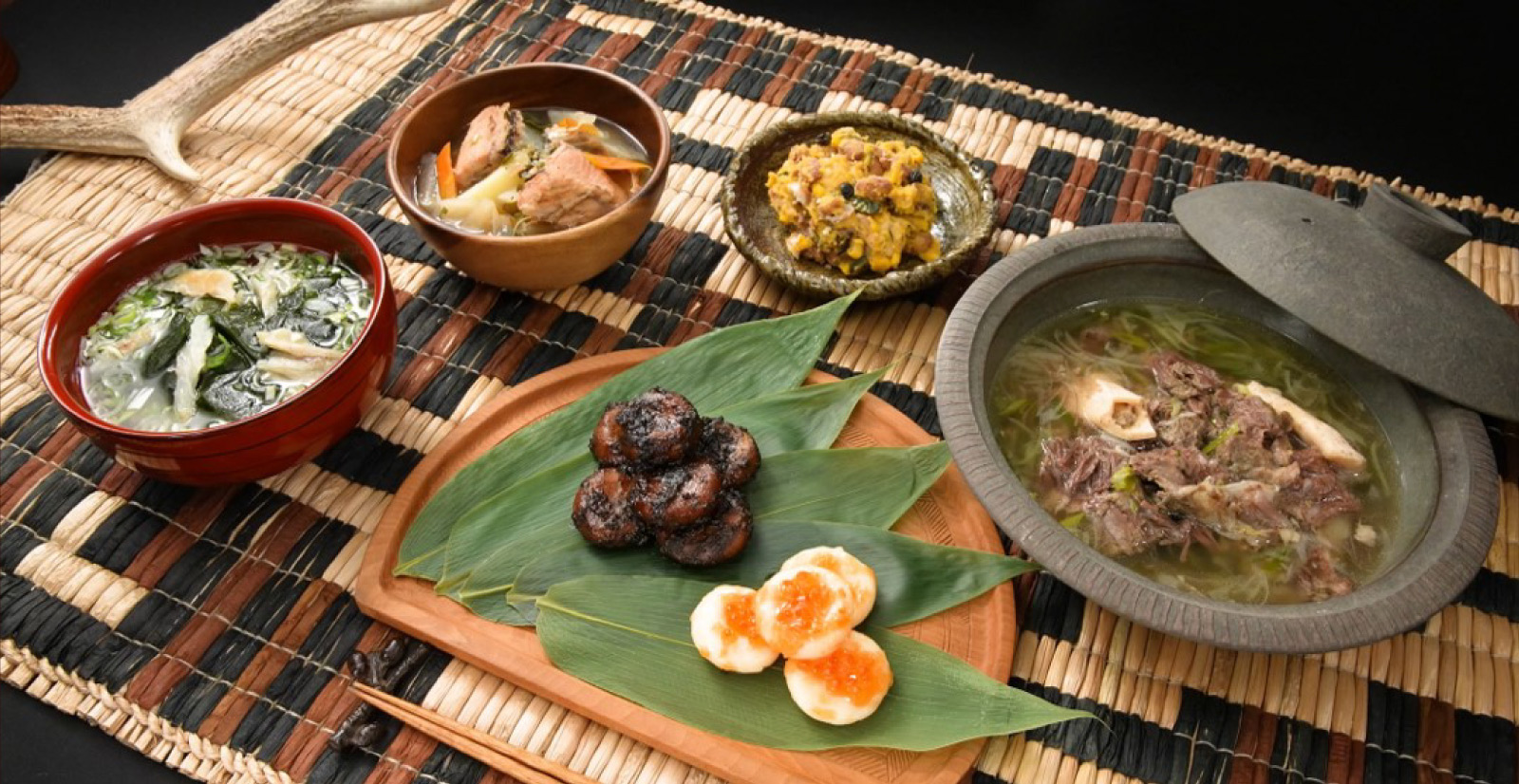
様似の代表的なアイヌ料理
Samani Ainu Dances様似のアイヌ舞踊
There are many diverse types of Ainu dances, such as dances that use plants or animals as a motif, dances to drive away demons, and dances that express the tasks of daily life. Unique dances have been passed down in each region.
アイヌ民族の踊りは、動植物をモチーフにした踊りや悪魔祓い、普段の作業を現した踊りなど実に多彩で、地域ごとに独特の踊りが伝えられています。
Samani, too, is a source of unique Ainu dances, which were designated as Nationally-Important Intangible Folk Cultural Properties in 1994, and further received certification as UNESCO Intangible Cultural Heritage in 2009. One of these dances is "Hun Tori Hun Cikap: Dance of the Parent and Child Cranes". This dance expresses a sequence of events beginning with the mother crane warming her egg, the steady growth of the newborn crane chick, the mother teaching the chick how to fly, and concludes with the mother and child cranes flying together.
様似にも独自のアイヌ民族の踊りがあり、それらは1994(平成6)年、国の重要無形民俗文化財に指定されました。2009年にはユネスコ無形文化遺産に認定されました。その一つが、「フン トリ フン チカㇷ゚・親子ヅルの舞」。親鳥が卵をあたため、生まれたひなが徐々に成長し、飛び方を教わって一緒に飛んでいくまでの様子を表しています。
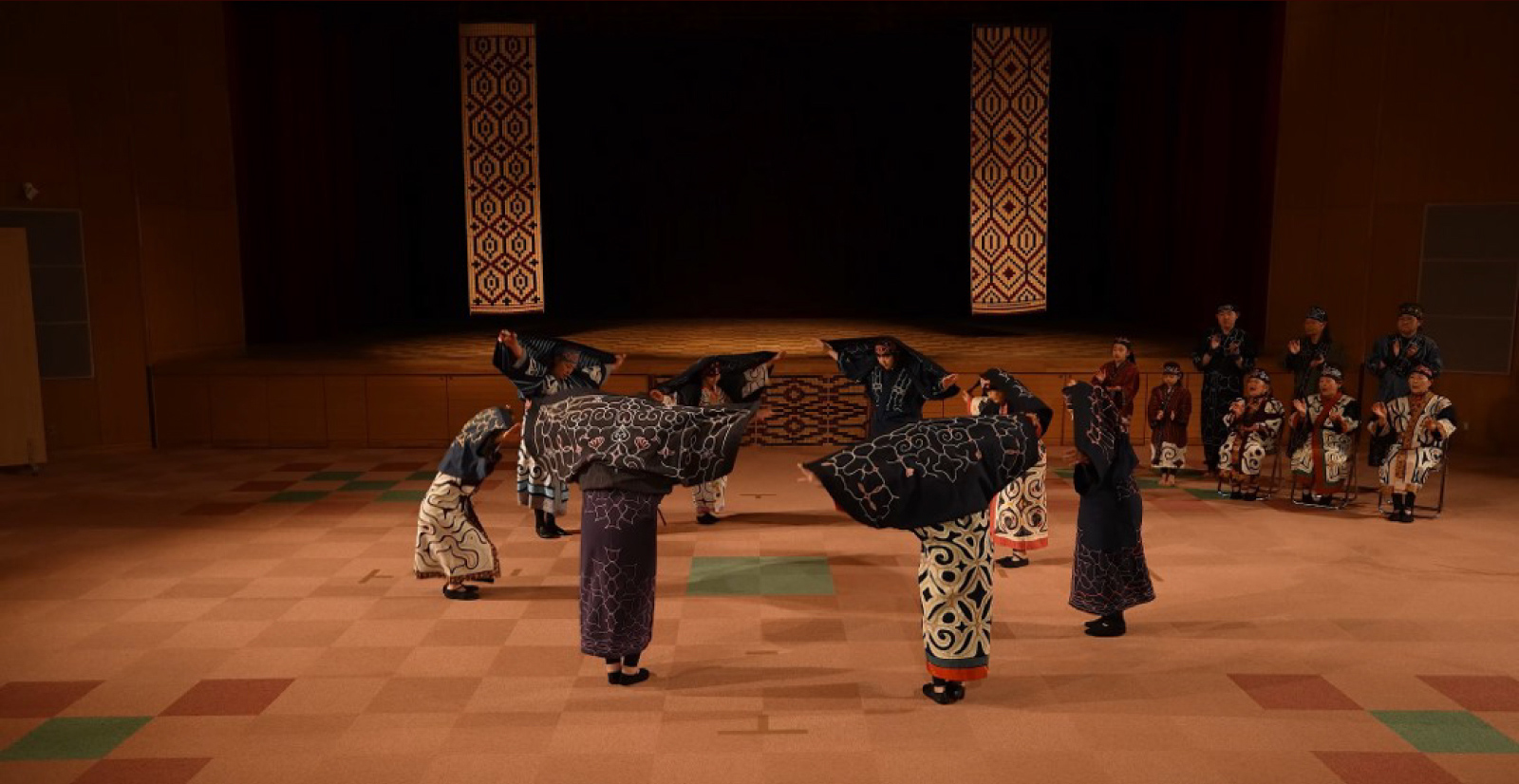
フン トリ フン チカㇷ゚・親子ヅルの舞
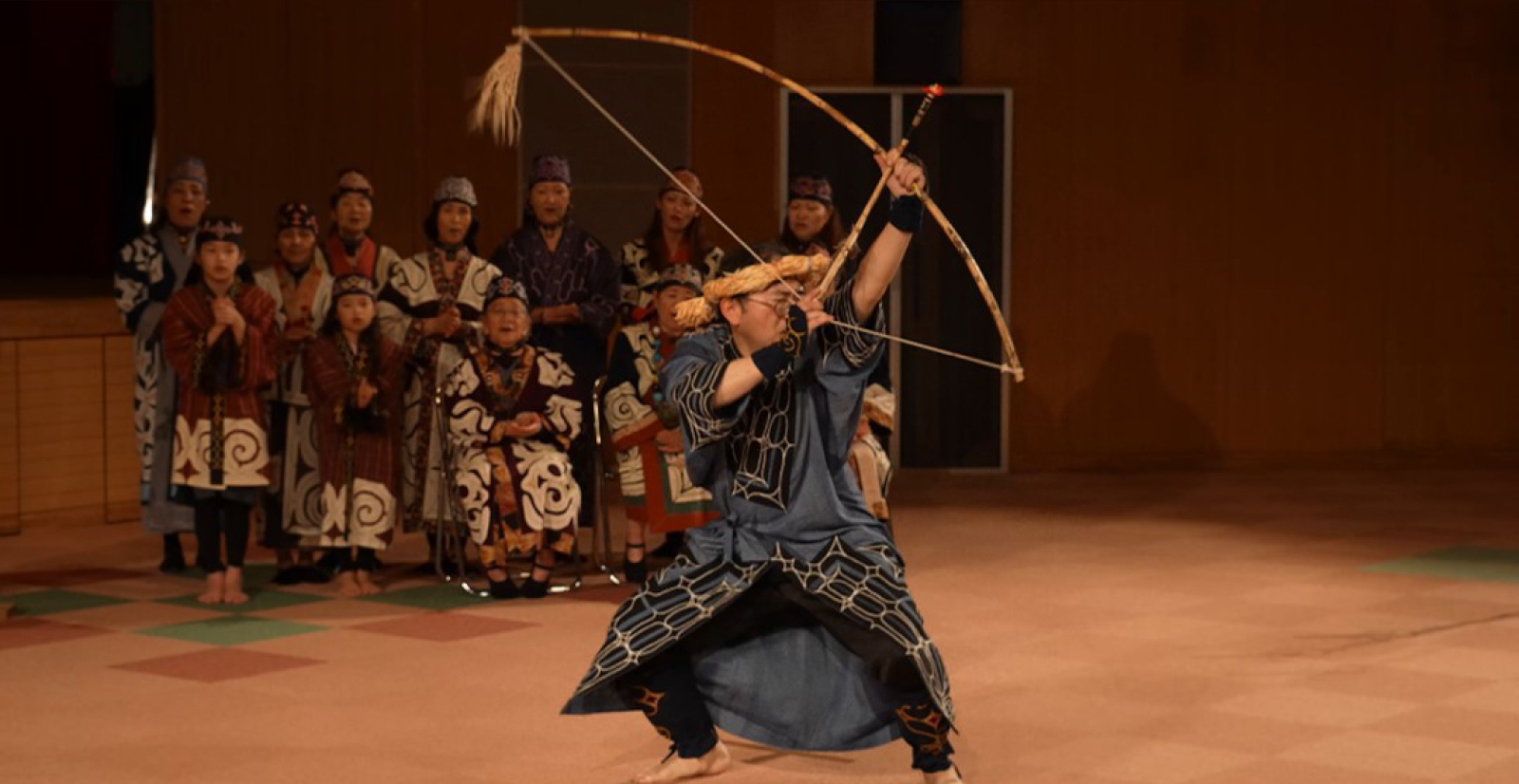
クリㇺセ・弓の舞い
"Sikata Kuykuy" is a dance passed down in the Samani area that expresses a scene from nature. "Sikata" means a strong wind that blows from the East. The dance symbolizes falling snow brought by the Eastern winds that settles on a tree branch, which then sags under the weight of the snow.
「シカタ クイクイ」は、様似地方に伝わる自然の情景を表した踊りです。シカタというのは、東から吹く強い風の意味。雪が東風に乗って舞うように降ってきて、木の枝に積もり、枝が重くたわむさまを踊りにしたものです。
Samani Ainu Traditional Ritual様似のアイヌの伝統行事
"Icarpa", the ancestral memorial service, is a traditional ritual performed in Samani even today.
"Icarpa" is held by the Samani Ainu Association every year at the end of May in the cise (Ainu house) in the Okada district.
In addition to dedicating offerings to deceased ancestors and remembering loved ones who have passed away, prayers are given for the health and safety of all participants.
現在、様似で行われているアイヌの伝統行事に、イチャㇽパ(先祖供養祭)があります。
毎年5月の終わりに、様似アイヌ協会が岡田地区のチセで行う「イチャㇽパ」。
亡くなった先祖に供物を捧げ、故人を偲ぶと共に、全員が健康で無事に過ごせるよう祈りを捧げます。
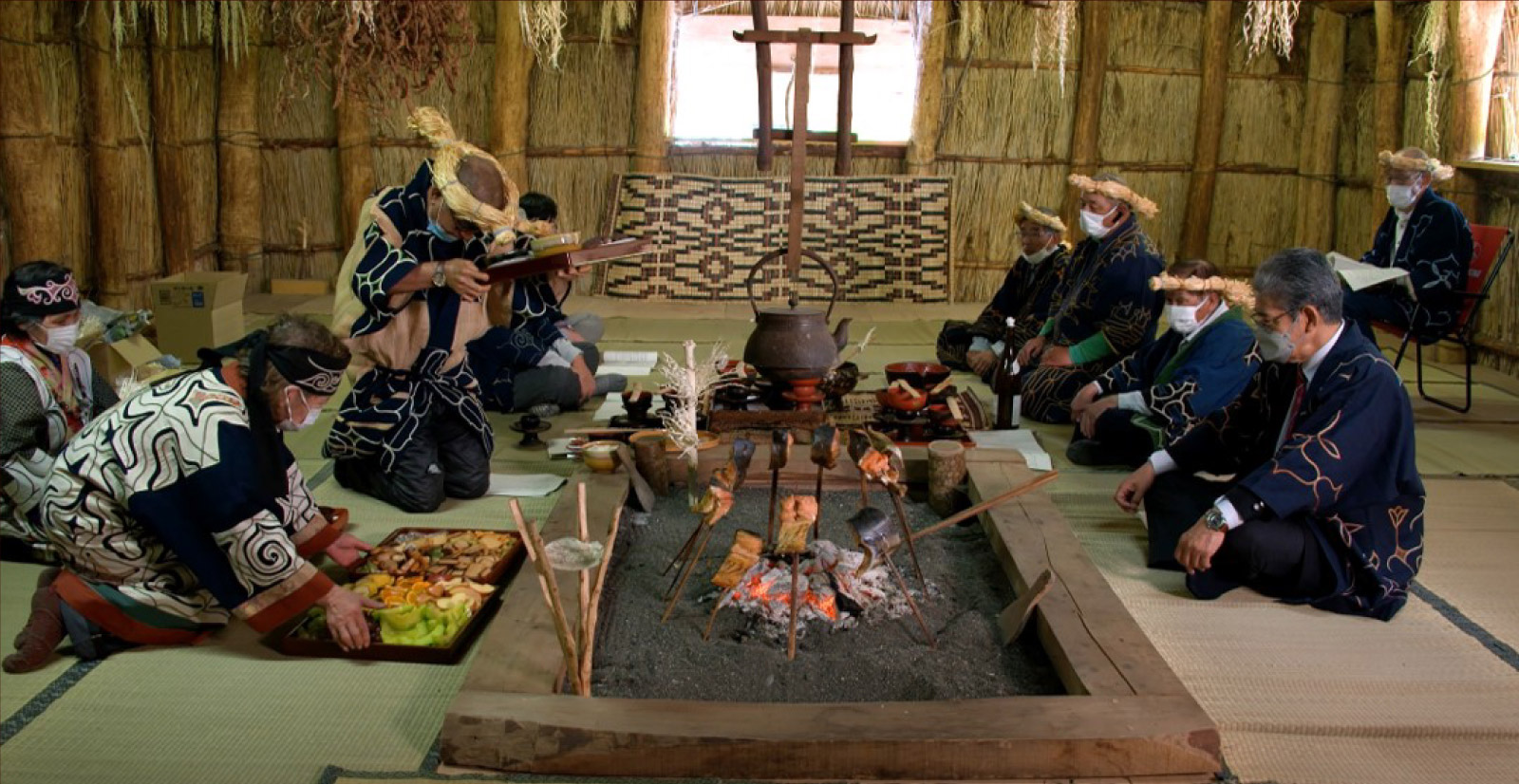
イチャㇽパ(先祖供養祭)
This is the traditional culture and the rituals of the Ainu people, who have always lived through coexistence with and respect for nature.
This culture has been ceaselessly handed down to the modern age.
自然を敬い、自然と共に生きてきたアイヌ民族の伝統文化や行事。
それは現代に、脈々と受け継がれています。
The Samani Ainu and their Interactions with Wajin様似アイヌと和人の交流
It is thought that Ainu people began to live in Samani around the middle and latter stages of the Early Jomon period (approximately 8,000 to 5,000 years ago).
様似にアイヌ民族が暮らし始めたのは、縄文時代早期中葉から後葉(約8,000~5,000年前)と言われています。
On the other hand, Wajin (Mainland Japanese) first came to Samani in 1635, the early Edo period. This was said to have occurred when gold mining operations began at the upper reaches of the Poronai River, a tributary of the present-day Unbe River.
一方、和人が様似に入ってきたのは江戸時代初めの1635(寛永12)年。現在の海辺川支流のポロナイ川上流で、金の採掘が始まったあたりだと言われています。
The gold mine attracted large numbers of miners, and the Kirishitanai district near the mouth of the Unbe River became a thriving area as a result. However, in 1669, the mine closed down due to the Battle of Shakushain.
鉱山に多くの採掘人が入ったことで海辺川河口付近のキリシタナイ地区は大いに栄えましたが、1669(寛文9)年、シャクシャインの戦いにより鉱山は閉山してしまいます。
During the second half of the Edo period when the shipping trade flourished, Samani gradually developed as a base for marine traffic in the Eastern Ezo area. Following the establishment of Shamani Kaisho (Shogunate Trade Office), which combined the functions of a trading post and a traveler's inn, a town formed with the Kaisho at its center, and trade with the Ainu people took place. Around this time, the distribution of goods by ship became full-scale.
江戸時代後半に入ると海運が盛んになり、東蝦夷地エリアの海上交通の拠点として様似は発展していきます。交易・旅籠屋の機能を兼ねたシャマニ会所が設置されたあとは、そこを中心に市街が形成され、アイヌ民族との交易が行われました。この頃から船による商品物流が本格化。
Products from Samani Kaisho such as kombu (kelp), funori (marine glue), dried cod, and fish oil were transported across Japan by Kitamae ships.
シャマニ会所の産物である昆布やふのり、干しタラ、魚油なども北前船によって全国へ運ばれました。
As the number of Wajin settlements increased throughout Eastern Ezo, the Edo Shogunate established several temples. One of these was Tojuin Temple, where it is thought that cultural contact with Ainu people took place.
東蝦夷の各地に和人の集落が増えたことにより、江戸幕府は寺院を設立。その一つが、「等澍院」で、ここでアイヌの人々との文化的接触があったと考えられています。
In the Meiji period, after the Kaisho system was abolished, the local merchant Yamoto Kuragoro carried out trade with Ainu people, as recorded in the "Yamoto Family Documents" held in the collection of SAMANI Folk Museum.
明治時代に入り会所廃止後は、地元の商人・矢本蔵五郎がアイヌ民族との交易を行ったと、様似郷土館所蔵の「矢本家文書」にのこされています。
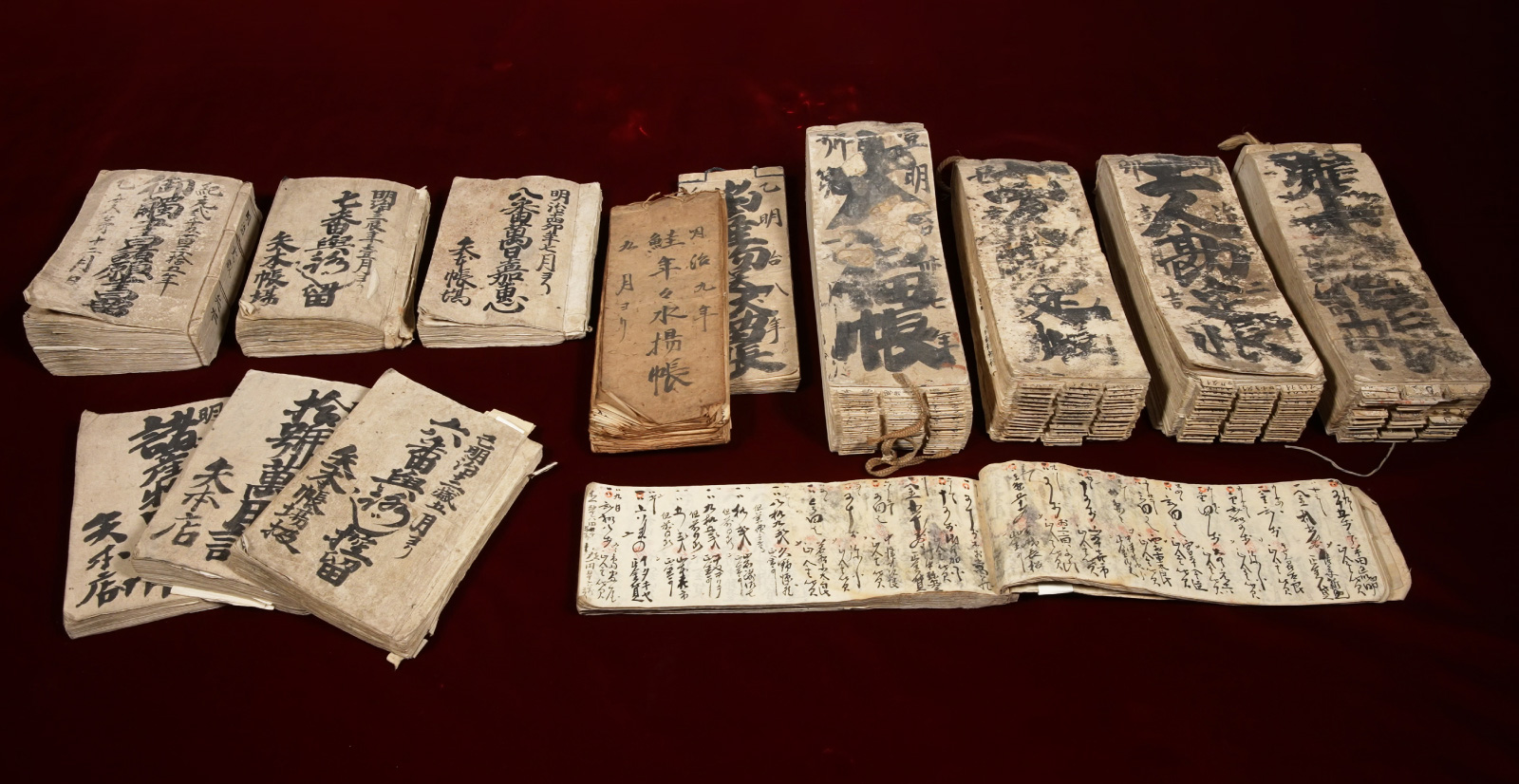
矢本家文書/様似郷土館所蔵
